When you ask an expert or a professional about which is the best camera of 2024, you'll probably will receive a different answer from both. Depending on what you want to use it for, the best camera for recording YouTube videos won't be the same as a camera you would pick for live streaming on Twitch, a holiday or for starting as an influencer. In this article we've collected a wide range of camera models at different price points, including, action cameras, smartphones, DSLR's, mirrorless cameras and purpose-made cameras. All of the included cameras film video in completely different ways and some models are better alternatives than others.
With that said, let's dive right in!
In this article
1. Fujifilm X-S10
The Fujifilm's X-S10 has a 26-megapixel interchangeable lens that shoots high-quality 4K video and has a deep grip and a different, though splendid, control scheme than other Fujifilm cameras. Fujifilm describes the X-S10 as a mix between the Fujifilm's X-T30 and the X-H1 series. You get the strength from the previous model and the design and in-body photo stabilization. This X-S10 camera is suitable for both beginners and experienced users that use Nikon or Canon DSLR's and want something a little more similar than a regular Fujifilm camera.
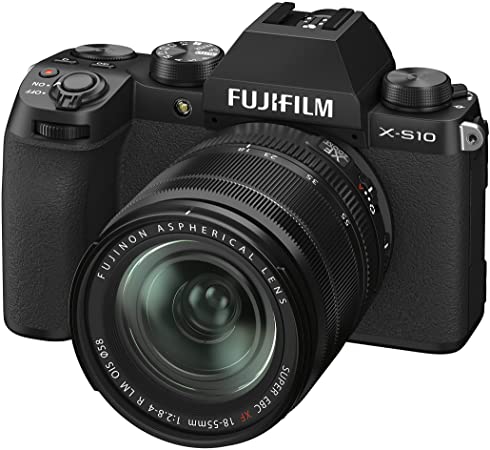
Fujifilm did not disclose what the S is standing for in the name of the X-S10, we think it might stand for 'small' or 'slim', or maybe 'simple'. Let's take a look at the details: the X-S10 measures 126 x 85x 65 mm and weighs 465 grams. For the dimensions, it lays between the X-T30 and the X-T4.
Fujifilm X-S10 specifications
- Single UHS-I card slot
- 5-axis in-body image stabilization
- Wi-Fi + Bluetooth
- On-sensor phase detection
- 325 shots per charge using LCD
- 26MP X-Trans BSI-CMOS sensor
- 3", 1.04M-dot fully articulating touchscreen
- 30 fps burst shooting with crop (up to 20 fps without)
- USB Power Delivery support
- 36M-dot OLED electronic viewfinder
- DCI and UHD 4K capture at up to 30p with F-Log support
- External mic and headphone sockets
2. Canon EOS R5
In our opinion, the Canon EOS R5 is by far Canon's most precious product. It's the perfect combination of the EOS R's form, the EOS 5D's function, together with the professional autofocus of the EOS-1D X. If you're a hybrid or a stills shooter who shifts between videography and photography. It's one of the most robust cameras you will ever own. It has achieved a lot of wrong attention, probably for overheating (or the possibility of it) when recording your videos in 8K resolution. But this should not decrease the quality of this camera's incredible potential.
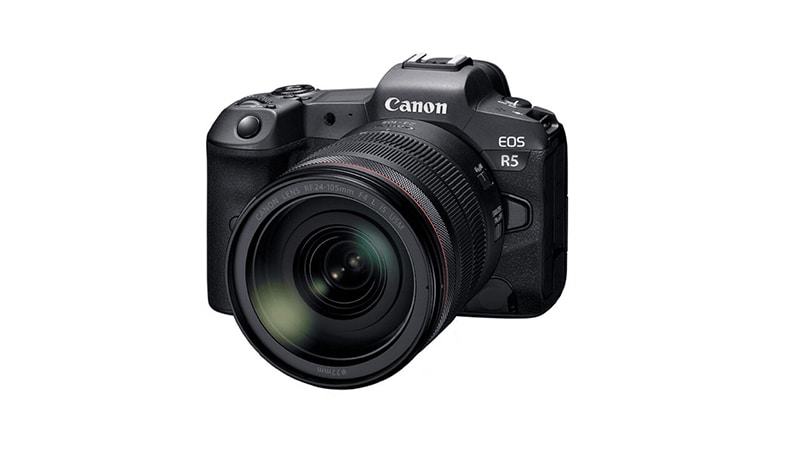
With its frame rate and its video capabilities combined together, this is honestly a monumental camera. It's taken the spot of the more expensive Sony A1 just to see how good this EOS R5 from Canon is. The Canon EOS R5 is incredible at photographing wildlife, it's more or less a way around for capturing images of animals and people, or other objects from far away or close-up shots.
For the professional photographer who needs speed, video capabilities and resolution, there is the Canon EOS R5. Setting a new boundary for versatility, the full-frame mirrorless camera contains a perfectly designed 45-megapixel CMOS sensor, which offers 12 fps continuous shooting with a mechanical shutter, 8K raw video recording. It's the first EOS camera to contain a 5-axis sensor-shift image stabilizer.
Canon EOS R5 specifications
- ISO range: 100-51,200 (expandable to 50-102,400)
- Image processor: Digic X
- AF points: 5,940 Dual Pixel CMOS AF II
- Sensor: 45MP full-frame CMOS 36 x 24mm
- Max image size: 8,192 x 5,464px
- Video: 8K DCI or UHD at 30p, 24p / 4K DCI or UHD at 120p, 100p, 60p, 50p, 30p, 25p, 24p / 1080p (FullHD) at 60p, 50p, 30p, 25p, 24p
- Max burst: 12fps mechanical shutter, 20fps electronic shutter
- Viewfinder: 0.5-inch OLED EVF, 5,690k dots, 100% coverage, 0.76x magnification, 120fps refresh rate
- Memory card: 1x CFexpress type B, 1x UHS-II SD/SDHC/SDXC
- Stabilization: 5-axis, up to 8 stops
- Metering zones: 384
- LCD: 3.15-inch fully articulating touchscreen, 2,100k dots.
- Connectivity: Wi-Fi 5Ghz and 2.4GHz, Bluetooth 4.2, USB-C (USB 3.1 Gen 2), micro HDMI (type D), microphone, headphone, N3 remote, flash sync, gigabit ethernet (via WFT-R10 grip)
3. Nikon D3500
The Nikon D3500 is one of the best DSLR cameras available for beginners that are looking to create stunning, manual photos using a regular setup. While it's containing great image quality, easy-to-use menus and a superior battery life, this camera offers incredible value. Mirrorless competition should also be contemplated, especially when you want 4K resolution or a touch screen for easier use. After our review, this Nikon's entry-level DSLR keeps the lead by giving the type of value and quality that mirrorless cameras do not succeed to accomplish.
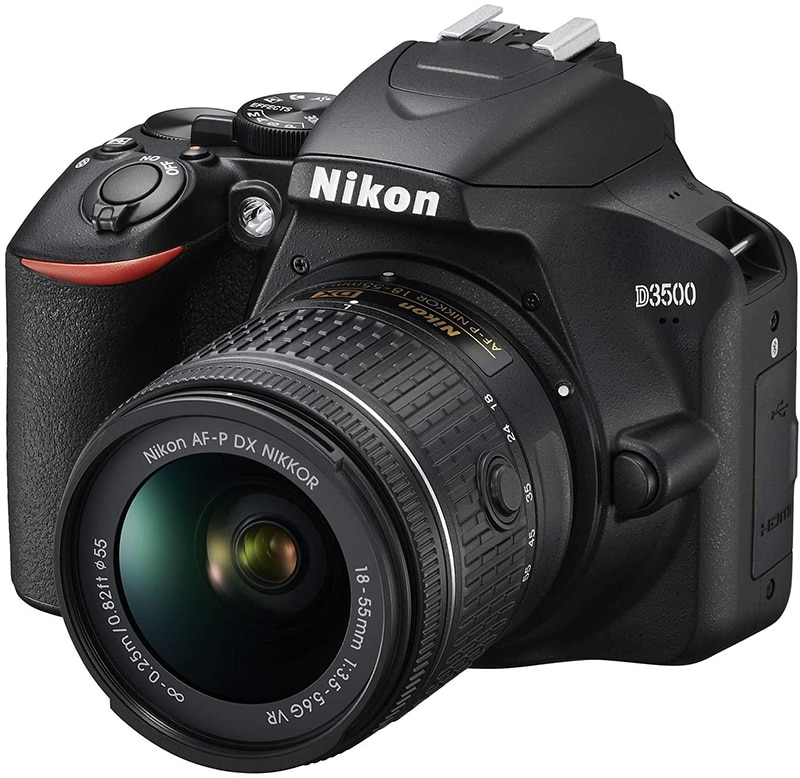
When you are searching for a smaller camera for recording traveling content, other mirrorless options like the Canon EOS M50 Mark II or Fujifilm X-T200 are great possibilities too. When it comes to an affordable camera for starters, the Nikon D3500 is the perfect solution. The D3500's ISO sensitivity range of 100-25,600 is quite wide and doesn't improve on the D3400's range.
Nikon decided to keep the same 3-inch display, including the 921,000-dot resolution from the D3400 model. If you desire a DSLR with a vari-angle display, then you should explore the range to the Nikon D5600.
Seeing the rear screen is an optical viewfinder. This is perhaps the clearest feature that distinguishes DSLR's from mirrorless cameras. Many mirrorless cameras barely show on the rear screen for shooting, while other models will include viewfinders with quite better resolutions.
Nikon D3500 Specifications:
- Camera type: DSLR
- Sensor: 24.2MP APS-C CMOS 4, 23.5 x 15.6mm
- Lens mount: Nikon F
- In-body image stabilization (IBIS): No
- Full frame: No
- AF points: 11-point AF, 1 cross-type
- Image processor: EXPEED 4
- Memory card: SD/SDHC/SDXC UHS I
- Max image size: 6,000 x 4,000px
- ISO range: 100 to 25,600
- Video: 1920 x 1080 at 60p, 50p, 30p, 25p, 24p
- Metering zones: 420 pixel RGB sensor
- Viewfinder: Optical pentamirror, 95% coverage
- Max burst: 5fps
- LCD: 3.0-inch fixed, 921K dots
- Size: 124 x 97 x 69.5mm (body only)
- Connectivity: Bluetooth
- Weight: 415g (body only, with battery and memory card)
4. Olympus OM-D E-M10 Mark IV
Introducing the Olympus OM-D E-M10 Mark IV! This is the entry-level camera in Olympus's DSLR range of Micro Four Thirds models. This is definitely an upgrade from the beginner-range E-PL range, giving you more control, also improved quality and a wide range of features. This camera contains a 20-megapixel Four Thirds sensor, flip-down touchscreen, an in-body image stabilizer, an easy-to-use interface and of course the 4K video option. The E-M10 IV is out now in two types of kits, a black or silver body including the compact 14-42mm F3.5-5.6 EZ lens.
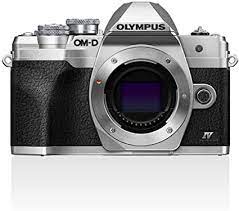
The camera's continuous autofocus has been redesigned using techniques from the E-M1X model. This reduces occurrences of the camera locking focus to the background and not focusing on your predetermined topic.
Olympus did also add a Live View Boost option that allows you to make both focusing and framing in darker environments a lot easier. The E-M10 III's Live View Boost option hardly increases the viewfinder drive, but on the E-M10 IV it can also diminish the frame rate. This allows a substantially more luminant viewfinder frame.
The E-M10 IV is still employing a contrast-detect autofocus structure, For us it's not a problem, even while shooting in 4K resolution. We noticed that the night display mode is way easier to use but implements only to the Remote Shutter screen. Its more red scheme supports in protecting your night vision while filming night skies, it does allows your external light source to be quickly changed with a vertical wipe onto the screen
Olympus OM-D E-M10 Mark IV specifications:
- 5-axis in-body image stabilization (up to 4.5 stops)
- 20 Megapixel Live MOS sensor (Four Thirds)
- 121-point contrast-detect AF system
- Wi-Fi + Bluetooth
- Flip-down touchscreen display
- TruePic VIII processor
- USB charging
- Electronic viewfinder
- 360 shots per charge (with LCD)
- 5 fps burst shooting w/AF
5. DJI Pocket 2
The DJI Pocket 2 is a second-generation all-in-one camera that has an amazing built-in three-axis stabilizer. This camera stays about the same capacity as the regular, and contains a wider lens, bigger sensor, more microphones, an improved autofocus system, with the option to film higher-quality videos photos.
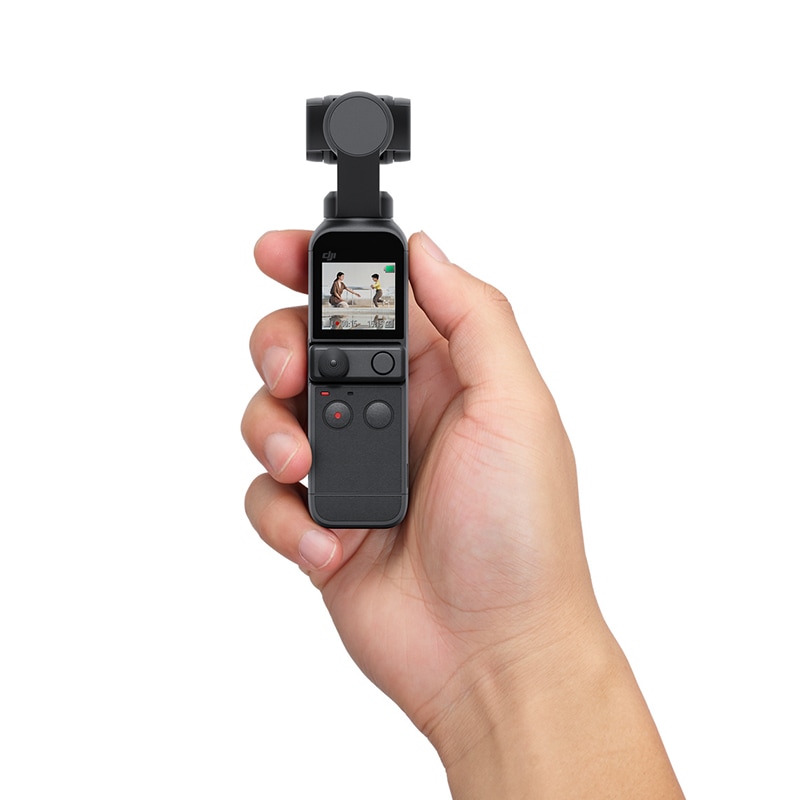
The design of the Pocket 2 is almost the same to the original and it holds a Mini Control Stick that shove into the area previously kept free for a smartphone placement. When you are using the Mini Control Stick, the buttons to operate the Pocket will increase to five from two. We want to mention that there are a few changes with the button design, the operation is still natural just like the original.
The DJI Pocket comes standard with all accessories to use with your smartphone without the Do-It-All handle.
You need to tilt and zoom using the smartphone app, and that is not as spontaneous as the Mini Control Stick. The Do-It-All handle is perfect for using your smartphone like the screen. It's crucial to download the Mimo application and the Do-It-All handle if you want to go stream.
The microphone quality on the Pocket is something to go for because of the extra microphones. It makes it super easy for recordings to sound way better than regular smartphones. The Pocket 2 has the option to shoot 3x3 panoramas. The 180º panorama captures four pictures and combines them into one long photo, while the 3x3 panorama mode captures 9 images and then puts them into a 5x7 image. We recommend a tripod with 3x3 panoramas to cancel out any camera shakes.
DJI Pocket 2 Specifications:
- DJI Pocket 2 specifications:
- 20mm (equiv.) F1.8 lens
- 1/1.7” CMOS sensor
- Video: 4K/60p, 2.7K/60p, 1080/60p
- Panorama modes in 3×3 and 180°
- 64MP and 16MP photo modes
- 4 microphones with directional audio and sound tracking
- 8x zoom (64MP mode), 4x lossless zoom in 1080p or 16MP mode
- 140 min. battery life (1080/24p)
- Micro SD slot up to 256 GB
- Dimensions: 124.7×38.1×30 mm
- Weight: 117 g
- HDR Video: 2.7K/30p (arriving in a future firmware update)
6. GoPro Hero 10 Black
When we think about action cameras designed for sports, GoPro is the first thing that comes to mind. According to our records, the GoPro Hero 10 Black is GoPro's new leader for 2024. It resembles a similar layout and the same sensor introduced on the GoPro Hero 9 Black edition. This camera is packed with a new processor. While the screens on the GoPro's are LCD's, they are not as crisp as AMOLED panels. The GoPro Hero 10 Black's interface is the same as what previous GoPro's. Wipe your finger to browse through the menus to go back and forth between the modes. Swipe up to show the video files on the memory card and swipe down to enter the camera settings.
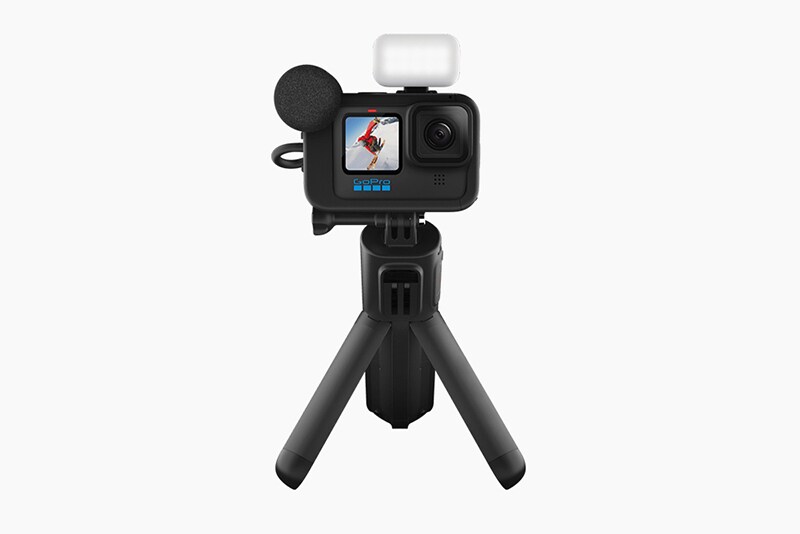
We can all agree that the GoPro Hero 9 Black is a solid camera, but its (sometimes) unresponsive LCD screen kind of broke people's expectations. GoPro handles feedback really well and the camera also boasts quicker frame rates. The entire GoPro experience also saw a punch up in terms of experiences. The GoPro app now reinforces wired transfers and better live streaming support. This GoPro Hero 10 Black also showcases a new HyperSmooth 4.0 stabilization, which keeps video steadier.
We like to point out that it is a good idea to consider that there is no headphone jack, microphone input and video output, because there will already be a built-in microphone and speaker on the GoPro Hero 10.
GoPro Hero 10 Black Specifications:
- GoPro Hero 10 Black specifications:
- Higher video framerates
- Top-of-the-line digital stabilization
- WiFi and Bluetooth Supported
- More effiecient wire transfer
- Digital Image Stabilization
- 1720 mAh rechargeable battery capacity via USB type-C
- The new lens cover can repel water
- No tripod mount and accessory shoe
- Better and improved user interface
- Waterproof of upto 10m
- Doubled processor power
- Interval Recording
- No built-in light/flash
- Creative Effects
- Burst Mode
7. Nikon Z6 II
The Nikon Z6 II is equipped with a whopping 24-megapixel sensor, it lays perfectly between processing power and resolution, a lot of people like the option to the professional grade Nikon Z7 II which comes with about the double megapixel count. There are not many differences between this camera and its forerunner. A difference is "II" nomenclature after the Z6 mark. We figured that it's just a couple of millimeters deeper. We know that the Z6 II is the cheaper model of the two, one is more-affordable and better designed compared to the more-expensive brother, the Z7 II. Nikon chose to keep both the Z6 and the Z7 in its range so there's would not be a reason why the upgrades available wouldn't fit you.
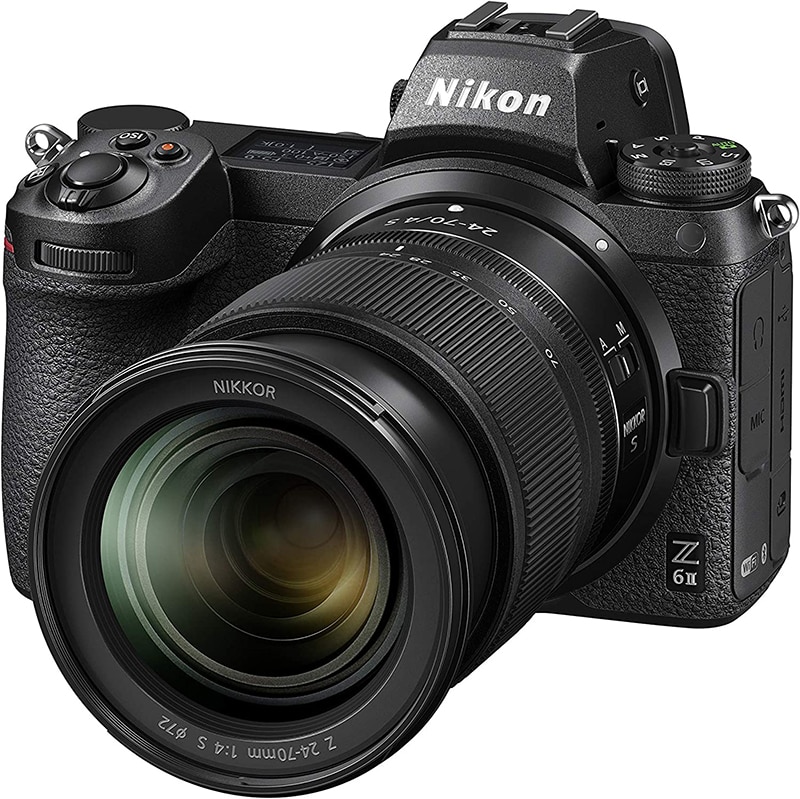
We noticed that most of the Z6 II's buttons are paired together to the right of the camera, so you can make changes with your fingers. The set of dials on the front and side of the grip feel natural to control aperture and its shutter speed. You see buttons for settings such as video recording, exposure compensation and ISO on the side. Even though there are no disappointments when talking about image quality. The Z6 II expresses the same sensor as its forerunner.
Personalize the controls on the Z6 II, on an attached lens and also on the body. You can navigate to the menu and configure these settings from there. In this camera model you also find the possibility to adjust how the focus ring acts on Z lenses (besides the Noct lens, which is not focus-by-wire). Because of the powered processing options comes a higher burst rate. We noticed an improved autofocus with support for Eye-AF in Wide Area AF modes.
To sum things up besides the specifications of this camera, we find this one of the most amazing full-frame mirrorless cameras available today. It has the lens mount and quality just right, despite the fact that is has much competition and considered not being a huge upgrade than the original model, the Z6 II is incredible in many way.
- Nikon Z6 II specifications:
- Full-sensor UHD 4K video at up to 30p
- 24MP full-frame BSI-CMOS sensor
- UHD 60p from an APS-C crop promised in future firmware update
- Continuous shooting at up to 14 fps (in 12-bit Raw with single AF point)
- 69M-dot EVF with improved blackout times
- Two card slots (1x CFexpress/XQD, 1x UHS-II SD)
- USB-C socket for recharging or powering the camera
- Tilting 2.1M-dot read touchscreen
- Connectors to allow battery grip with portrait orientation controls
- Battery rating of 410 (LCD) and 340 (EVF) shots per charge



 100% Security Verified | No Subscription Required | No Malware
100% Security Verified | No Subscription Required | No Malware


